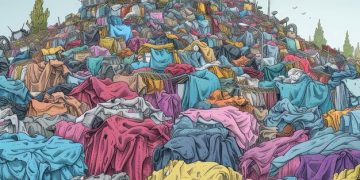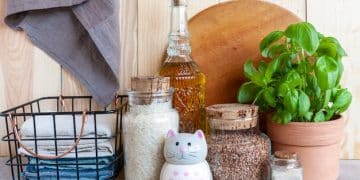Sustainable Fashion: Eco-Friendly Wardrobe on a Budget
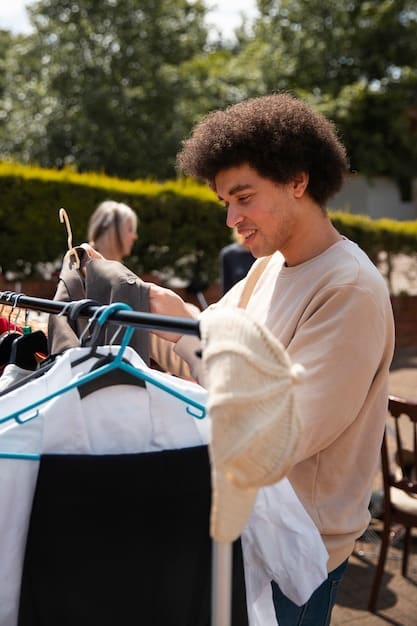
Achieving a sustainable wardrobe on a budget involves strategic choices like thrifting, DIY projects, conscious purchasing from ethical brands, and prioritizing garment longevity through proper care, reducing environmental impact without financial strain.
In a world increasingly aware of its ecological footprint, the allure of a stylish yet ethical closet is undeniable. But for many, the phrase “sustainable fashion” conjures images of exorbitant prices and exclusive boutiques, leading to the common misconception that an eco-conscious wardrobe is beyond reach. This article aims to demystify how to build an eco-friendly wardrobe on a budget, proving that thoughtful consumption doesn’t have to break the bank. It’s about making smarter choices, embracing creativity, and understanding the true value of your clothes.
Understanding Sustainable Fashion and Its Impact
Sustainable fashion is a broad term encompassing practices and processes that minimize the negative environmental and social impacts of the clothing industry. This industry, notoriously resource-intensive and often exploitative, is one of the world’s largest polluters. From the vast amounts of water and pesticides used in cotton cultivation to the chemical dyes polluting waterways and the sheer volume of textile waste ending up in landfills, the fashion supply chain presents significant challenges. Fast fashion, characterized by rapid production cycles, trend replication, and low prices, exacerbates these issues, encouraging disposable attitudes towards clothing.
The impact extends beyond environmental concerns. Social sustainability addresses fair labor practices, safe working conditions, and living wages for garment workers, many of whom are in developing countries and subjected to harsh conditions. Ethical brands strive to ensure transparency and accountability throughout their supply chains, from fiber to finished garment. Understanding these issues is the first step towards building a truly sustainable closet, as it shifts our perspective from mere consumption to conscious decision-making.
The Environmental Toll of Fast Fashion
The rapid cycle of fast fashion places an immense burden on the planet. Its resource consumption is staggering, impacting water scarcity and land degradation. Disposal of these garments presents an ongoing challenge, with most synthetic materials persisting for hundreds of years. This perpetual cycle of consumption and disposal demands a more thoughtful approach to our purchasing habits.
- Water Consumption: Growing cotton for a single t-shirt can require thousands of liters of water.
- Chemical Pollution: Dyes and treatments often release toxic chemicals into local ecosystems.
- Textile Waste: Landfills are overflowing with discarded clothing, much of it still wearable.
Social Implications of Unethical Production
Beyond environmental damage, the human cost of fast fashion is profound. Workers, often women, face poverty-level wages, unsafe factories, and restricted rights. The pursuit of cheap production compromises fundamental human dignity and creates systemic social inequalities. Supporting ethical brands becomes a crucial act of solidarity.
- Unsafe Working Conditions: Factories may lack proper ventilation, safety equipment, or emergency exits.
- Low Wages: Many garment workers cannot meet basic living costs with their earnings.
- Child Labor: Exploitation of children remains a concerning issue in some parts of the supply chain.
осознание этих проблем — это не просто теоретическая концепция, а практический призыв к действию. Понимание того, насколько сложной является индустрия моды, позволяет нам стать более информированными потребителями и, в свою очередь, способствовать позитивным изменениям.
Strategic Shopping: Thrifting and Secondhand Finds
One of the most effective and budget-friendly ways to cultivate a sustainable wardrobe is by embracing secondhand shopping. Thrifting, rummaging through consignment stores, and exploring online resale platforms not only give garments a second life but also significantly reduce the demand for new production. This approach dramatically cuts down on resource consumption, waste, and the carbon footprint associated with manufacturing new clothes. It’s an accessible and exciting treasure hunt where unique pieces with character await discovery.
The key to successful secondhand shopping lies in patience and a keen eye. It’s not about finding specific items but being open to what’s available and identifying quality pieces that can be integrated into your existing wardrobe. Look for durable fabrics, strong stitching, and classic styles that transcend fleeting trends. Developing a mental list of wardrobe gaps or desired staples can guide your search, but be prepared for serendipitous finds.
Where to Find Secondhand Treasures
The landscape of secondhand shopping has expanded considerably beyond local thrift stores. Online platforms, specialized consignment shops, and even clothing swaps offer diverse avenues for discovery. Each avenue presents unique benefits, from the thrill of an in-person discovery to the convenience of curated online selections.
- Local Thrift Stores: Often offer the lowest prices and a wide variety of items.
- Consignment Shops: Curated collections, often with higher-quality or designer pieces.
- Online Resale Platforms: Websites like ThredUp, Poshmark, and Depop provide vast selections and convenient home delivery.
- Vintage Stores: Specializing in older, often unique and high-quality items.
Tips for Successful Thrifting
Navigating secondhand stores can be overwhelming at first, but with a few strategies, it becomes an enjoyable and rewarding experience. Focus on inspection, fit, and potential for alteration. The goal is to find pieces that truly enhance your wardrobe, not just add to it. A systematic approach helps prevent impulse purchases that ultimately go unworn.
- Inspect Carefully: Check for stains, tears, broken zippers, and missing buttons.
- Know Your Brands: Recognize quality brands that are known for durability.
- Try It On: Sizes vary, so always try on garments to ensure a good fit.
- Visualize Outfits: Think about how a piece will integrate with your current wardrobe.
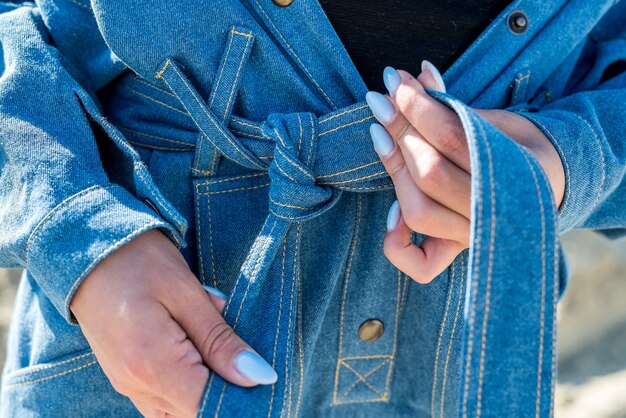
Secondhand shopping is more than just saving money; it’s a conscious decision to reject rapid consumption and embrace a circular economy. It’s an empowering act that redefines our relationship with clothing, moving towards a model of reuse and appreciation.
Embracing Durability and Longevity
A cornerstone of sustainable fashion, especially when on a budget, is prioritizing durability and garment longevity. Investing in high-quality pieces that last for years, rather than succumbing to the cycle of disposable fast fashion, is more economical in the long run and significantly reduces environmental impact. A well-made garment, even if it costs a bit more upfront, will outlast multiple cheaper alternatives, saving money and resources over time. This approach shifts focus from quantity to quality, encouraging a more mindful consumption habit.
Identifying durable clothing involves understanding fabrics, construction, and brand reputation. Natural fibers like organic cotton, linen, hemp, and wool tend to be more durable and biodegrade more easily than synthetics. Look for dense weaves, reinforced seams, and quality hardware (zippers, buttons). A classic design that isn’t tied to a fleeting trend will also extend a garment’s wearable life, ensuring it remains a staple in your wardrobe for seasons to come.
Fabrics That Last
Choosing the right fabric is fundamental to garment longevity. Natural fibers often offer superior durability, breathability, and aging characteristics compared to their synthetic counterparts. They also tend to be more repairable and less prone to microplastic shedding, contributing to a healthier environment. Understanding fabric properties empowers more informed purchasing decisions.
- Organic Cotton: Durable, breathable, and softer with age, without harmful pesticides.
- Linen: Extremely strong and becomes softer with each wash, ideal for warm climates.
- Hemp: Known for its strength and resistance to stretching, similar to linen but with a better drape.
- Wool: Naturally resilient, odor-resistant, and maintains its shape well.
Caring for Your Clothes for Longevity
Proper garment care is just as crucial as initial quality. Simple habits can dramatically extend the life of your clothes, reducing the need for frequent replacements. This not only saves money but also minimizes your environmental footprint by lessening laundry’s impact. Gentle washing, air drying, and timely repairs are key pillars of a long-lasting wardrobe.
- Read Care Labels: Follow washing and drying instructions carefully.
- Wash Less Frequently: Over-washing can wear out fabrics and waste water.
- Air Dry: Reduces energy consumption and prevents fabric damage from high heat.
- Repair and Mend: Learn basic sewing skills to fix small tears or replace buttons.
By prioritizing durability and meticulously caring for our clothes, we participate in a sustainable cycle that honors resources and craftsmanship. This thoughtful approach transforms our closets into collections of cherished, lasting items.
DIY and Upcycling: Creative Solutions
For those building an eco-friendly wardrobe on a budget, embracing do-it-yourself (DIY) projects and upcycling offers an unparalleled opportunity for creativity, personalization, and significant savings. Instead of discarding worn-out or ill-fitting garments, these practices transform them into new, functional, and stylish pieces. Upcycling diverts textile waste from landfills, reduces the demand for new materials, and allows for the expression of individual style without contributing to the fast fashion cycle. It’s a rewarding way to extend a garment’s life and give it a unique story.
DIY and upcycling can range from simple alterations to complete garment transformations. Basic sewing skills, a little imagination, and perhaps some online tutorials are all you need to get started. Think about adding patched details to a pair of jeans, transforming an oversized shirt into a cropped top, or even dyeing faded fabrics a vibrant new color. This hands-on approach fosters a deeper connection with your clothes and their journey, moving away from a disposable mindset.
Simple Upcycling Projects
Even beginners can tackle numerous upcycling projects, saving money and expressing personal style. These projects require minimal tools and offer instant gratification, turning forgotten items into wardrobe favorites. They also provide an excellent opportunity to reduce textile waste at an individual level.
- Cropping T-shirts or Sweaters: Turn outdated lengths into modern styles.
- Distressing Jeans: Add rips or faded areas for a unique look.
- Adding Patches or Embroidery: Conceal stains or tears while personalizing items.
- Dyeing Faded Garments: Revitalize dull colors with fabric dyes.
Advanced DIY for a Unique Wardrobe
For those with more experience or a willingness to learn, advanced DIY techniques can transform entire garments. These projects allow for significant customization and the creation of truly one-of-a-kind pieces. They highlight the artistry involved in garment construction and offer a profound sense of accomplishment.
Consider transforming an old pair of jeans into shorts or a skirt. This requires precise cutting and hemming, but the result is a custom piece tailored to your preferences. Another popular project is deconstructing larger garments, like men’s shirts or oversized dresses, into smaller, more fitted items. This often involves reshaping the silhouette, adjusting sleeves, or adding new closures. Learning these skills can be an incredibly empowering journey, not only for your wardrobe but also for developing a deeper appreciation for craftsmanship. Furthermore, exploring techniques like visible mending, where repairs become decorative elements, celebrates the garment’s history rather than concealing imperfections.
Upcycling is not just about saving money; it’s about nurturing a resourceful, creative spirit and actively participating in a circular fashion economy. It turns old into new, waste into treasure, making sustainable fashion accessible and fun.
Building a Versatile Capsule Wardrobe
A powerful strategy for embracing sustainable fashion on a budget is developing a capsule wardrobe. This approach involves curating a limited collection of interchangeable clothing items that can be mixed and matched to create a multitude of outfits. The philosophy behind a capsule wardrobe is to prioritize quality over quantity, versatility over fleeting trends, and intentionality over impulse purchases. By focusing on essential, well-made pieces, you reduce the need for constant updates, save money, and significantly minimize your fashion footprint.
The process begins by identifying your personal style, lifestyle needs, and preferred color palette. Opt for timeless pieces in neutral colors that can serve as foundational elements, then add a few accent pieces for flair. This approach encourages mindful shopping, as every new addition must serve multiple purposes and integrate seamlessly with existing items. It simplifies decision-making, promotes creativity in styling, and ultimately leads to a more sustainable and functional closet.
Benefits of a Capsule Wardrobe
Beyond its sustainable advantages, a capsule wardrobe offers numerous practical benefits that streamline daily life and enhance personal well-being. It simplifies morning routines, reduces clutter, and fosters a deeper connection with individual style. The focus shifts from accumulating to curating, leading to greater satisfaction with one’s possessions.
- Reduced Consumption: Less buying means less textile waste and resource depletion.
- Cost Savings: Fewer purchases lead to significant long-term financial benefits.
- Less Decision Fatigue: Easier to choose outfits when options are curated and versatile.
- Increased Creativity: Forces you to be more imaginative with styling existing pieces.
Steps to Create Your Capsule Wardrobe
Embarking on a capsule wardrobe journey requires thoughtful planning and an honest assessment of your current clothing habits. It’s a process of refinement, stripping away the superfluous to reveal the truly essential. The initial decluttering phase is crucial, providing clarity on what you already own and what gaps truly exist.
Start by decluttering your current closet. Take everything out and sort items into “keep,” “donate/sell,” and “discard” piles. Be ruthless, keeping only what truly fits, flatters, and brings you joy. Next, identify your core needs based on your lifestyle (work, casual, special occasions) and determine a base color palette (e.g., black, navy, grey, white) for your foundational pieces. Then, select versatile core items like well-fitting jeans, classic shirts, and a versatile jacket. Finally, add a few accent pieces – perhaps a colorful scarf or a statement accessory – to add personality. Remember, a capsule wardrobe is not about strict rules but about intentionality and versatility, allowing for gradual evolution as your style and needs change.
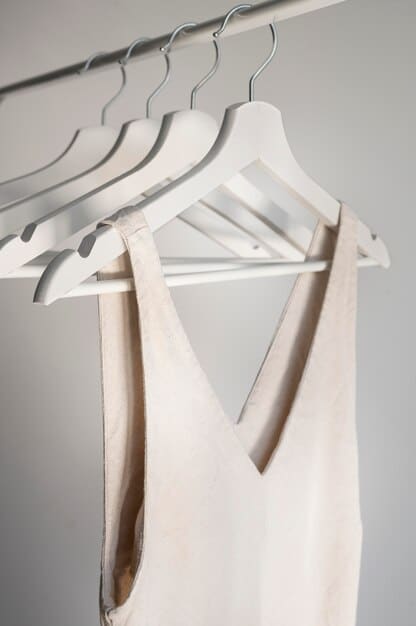
A capsule wardrobe is a powerful tool for sustainable living, encouraging thoughtful consumption and a renewed appreciation for the clothes we own. It simplifies life, saves money, and makes a positive impact on the planet.
Ethical Brand Choices and Mindful Consumption
While secondhand shopping and DIY offer fantastic budget-friendly avenues for sustainable fashion, there will inevitably be times when purchasing new items is necessary. In these instances, choosing ethical and sustainable brands becomes paramount. This requires a shift from convenience-driven shopping to conscious consumerism, where research and vigilance replace impulse buying. Ethical brands prioritize fair labor practices, environmentally friendly materials, reduced waste, and transparency in their supply chains. They strive to offer products that are not only stylish but also produced with integrity, minimizing harm to people and the planet.
Shopping ethically on a budget might seem challenging, but it’s increasingly feasible as more brands emerge with sustainable missions. Look for certifications (like GOTS for organic cotton or Fair Trade), read about a company’s mission and sourcing, and prioritize brands that offer durable, timeless pieces designed to last. Even small, incremental changes in purchasing habits can collectively create a significant positive impact, pushing the industry towards more responsible practices. It’s about being an informed consumer and using your purchasing power to support values-aligned businesses.
Identifying Truly Ethical Brands
The term “sustainable” can be easily co-opted for marketing purposes, making it challenging for consumers to distinguish genuine ethical brands from those engaged in greenwashing. Transparency and verifiable certifications are key indicators. Look for brands that are open about their factories, material sourcing, and labor practices, providing detailed information that goes beyond vague claims. This diligence empowers consumers to make truly impactful choices.
- Certifications: Look for third-party certifications like GOTS, Fair Trade, or bluesign.
- Transparency: Brands that openly share their supply chain, factory locations, and worker conditions.
- Material Sourcing: Preference for recycled, organic, or sustainably grown fibers.
- Durability Focus: Brands that design for longevity and offer repair services.
Budget-Friendly Ethical Shopping Strategies
Integrating ethical brand purchases into a budget-conscious strategy involves smart planning and prioritization. It’s about making thoughtful investments rather than frequent, cheap buys. Consider the long-term cost-per-wear and the environmental benefit when evaluating a purchase. This approach aligns financial prudence with ethical responsibility, proving they are not mutually exclusive.
- Save Up for Key Pieces: Prioritize investing in versatile, high-quality ethical staples.
- Shop Sales: Many sustainable brands have seasonal sales where you can find good deals.
- Follow Ethical Brand Outlets: Some brands have online outlets for past-season or slightly imperfect items.
- Consider Small Businesses: Often, smaller brands have strong ethical foundations and unique offerings.
Mindful consumption extends beyond the initial purchase; it involves being aware of how our choices contribute to a larger system. By consciously supporting ethical brands, even occasionally, we reinforce a demand for more responsible practices in the fashion industry.
Maintaining and Disposing Responsibly
The journey towards an eco-friendly wardrobe doesn’t end with mindful purchasing; it extends to how we care for and eventually dispose of our clothes. Proper maintenance significantly prolongs a garment’s life, reducing the frequency of replacements and minimizing environmental impact. When an item truly reaches the end of its wearable life, responsible disposal ensures it doesn’t simply contribute to overflowing landfills. This holistic approach to clothing ownership embodies the full cycle of sustainable fashion, emphasizing care, repair, reuse, and recycling.
Learning basic mending skills, understanding fabric care, and knowing local textile recycling options are invaluable. Every stitch repaired, every garment properly washed, and every piece diverted from the trash stream contributes to a more circular economy. It’s about fostering respect for the resources involved in clothing production and understanding that even small individual actions accumulate into significant environmental benefits. This final stage closes the loop, ensuring that our fashion choices remain sustainable from acquisition to end-of-life.
Extending Garment Life Through Care
The lifespan of a garment is heavily influenced by how it’s maintained. Simple care routines can prevent premature wear and tear, preserving the integrity of fabrics and extending their usability. These practices reduce the overall environmental footprint by minimizing the need for new production. Investing a little time in care yields significant returns in sustainability and savings.
- Washing Wisely: Use cold water, gentle cycles, and eco-friendly detergents.
- Storing Properly: Fold delicate knits to prevent stretching; hang woven items on appropriate hangers.
- Addressing Stains Promptly: Treat stains quickly to prevent them from setting permanently.
- Repairing Minor Damage: Fix loose threads, small holes, or missing buttons immediately.
Responsible Disposal Options
When a garment is truly beyond repair or reuse, responsible disposal is the next crucial step. Landfilling clothes should be a last resort, especially for natural fibers that can decompose or synthetics that can be recycled. Exploring local options for textile recycling ensures materials are given another chance at life, diverting waste and conserving resources. This careful end-of-life planning is vital for a truly circular fashion system.
- Donation: If still wearable, donate to charities or secondhand stores.
- Textile Recycling Programs: Many municipalities or brands offer textile collection points.
- Composting Natural Fibers: Non-blended natural fibers (like 100% cotton or linen) can be composted.
- Upcycling into Rags: Turn worn-out items into cleaning cloths for household use.
By diligently maintaining our clothes and responsibly managing their end-of-life, we practice the ultimate act of sustainable fashion. It transforms consumption into stewardship, honoring every piece in our wardrobe from start to finish.
| Key Strategy | Brief Description |
|---|---|
| 👗 Thrifting/Secondhand | Find quality items at lower prices, reducing demand for new production and minimizing waste. |
| 🧵 DIY/Upcycling | Transform old clothes into new styles, extending garment life and expressing creativity. |
| ✨ Durability/Care | Choose quality fabrics and practice proper care to make clothes last longer, saving money. |
| 🛒 Ethical Shopping | Support brands with transparent practices, opting for sales or saving for key sustainable pieces. |
Frequently Asked Questions About Sustainable Fashion
Not necessarily. While some ethical brands have higher upfront costs due to fair labor and quality materials, strategies like thrifting, DIY, and focusing on garment longevity make sustainable fashion accessible on a budget. The long-term cost-per-wear of durable, well-cared-for clothing often outweighs that of cheaper, disposable fast fashion items.
Prioritize natural, sustainably sourced materials like organic cotton, linen, hemp, and Tencel (lyocell). Recycled fibers, such as recycled polyester or nylon, also help reduce waste. These materials generally have a lower environmental impact during production and are often more durable and biodegradable than conventional synthetics like virgin polyester.
Start by adopting mindful habits. Practice proper garment care (washing less, air drying), mend small tears, and explore upcycling projects to give existing clothes a new life. Create a versatile capsule wardrobe from your current items to reduce the urge for new purchases. Donate or recycle items responsibly when they are no longer wearable.
Fast fashion refers to the rapid production of trendy, inexpensive clothing designed for quick consumption and disposal. It’s unsustainable due to its high resource consumption (water, energy, chemicals), significant textile waste, and often exploitative labor practices in pursuit of low costs. It encourages a linear “take-make-dispose” model instead of a circular one.
Absolutely. Every thoughtful purchase, every recycled garment, and every repair contributes. Individual choices create collective demand, encouraging brands to adopt more sustainable practices. Your actions also inspire others, fostering a larger movement towards ethical consumption. Small changes accumulate into significant positive environmental and social impact over time.
Conclusion
Building an eco-friendly wardrobe on a budget is not an insurmountable challenge, but rather an exciting journey of conscious choices and creative solutions. From the thrill of discovering unique pieces in secondhand stores to the satisfaction of mending a beloved garment, every step towards sustainable fashion is a vote for a healthier planet and a more ethical industry. It’s about shifting our mindset from endless acquisition to thoughtful stewardship, embracing durability, creativity, and discernment in our purchasing habits. The path to a truly sustainable closet is not about perfection, but about progress—one thoughtful choice at a time.
